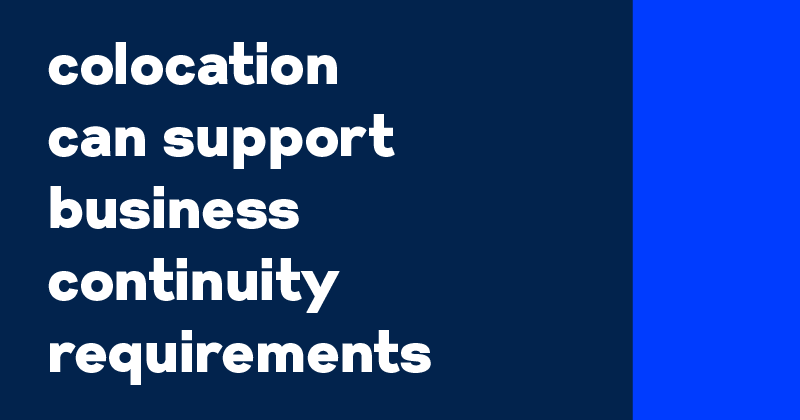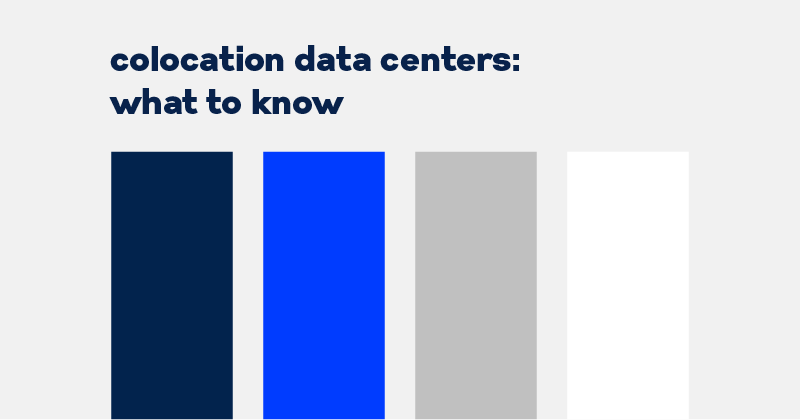Colocation Can Support Business Continuity Requirements

A disaster recovery (DR) plan can no longer be considered a “nice-to-have” business strategy — not that it ever should have been. It’s a must-have. Fortunately, there are numerous DR options available. An important one to consider: disaster recovery colocation.
Data at Risk
Before delving into how disaster recovery colocation can help, it’s important to understand why DR, in general, is so vital. Most organizations realize that anything that could cause a loss of access to their data or its destruction or corruption would be a disaster.
The problem is that many have hedged their bets, putting only the bare minimum in place to protect their data — like periodic onsite backup. Or they’ve held off implementing a comprehensive, tested DR plan altogether with the hopes that a disaster never happens.
“Disasters are not a matter of ‘if’ but ‘when’.”
Unfortunately, the chances of some form of disaster occurring seems to be growing, whether it’s a natural disaster like a hurricane or something human-initiated like a cyberattack, The costs due to those events seem to be increasing as well.
In its 2023 disaster report , the NOAA National Centers for Environmental Information (NCEI) confirmed that 2023 was a historic year in terms of costly weather and climate disasters in the US. There were 28 weather and climate disasters, with a price tag of at least $92.9 billion.
The Identity Theft Resource Center’s (ITRC) annual report on data breaches noted that in 2023 hackers unlocked personal information from millions of consumers through a record 3,205 data compromises. That’s a 78% increase from 2022.
Disaster Recovery Colocation
It’s not surprising that a lot of the information on DR solutions focus on Disaster Recovery as a Service (DRaaS) solutions. These cloud-based, managed DR solutions offer numerous benefits. But one DR option that doesn’t get as much coverage but should: colocation.
Colocation offers numerous benefits , but often doesn’t get attention for how it can contribute to DR. There are a couple of ways to look it. There’s the traditional colocation model and the secondary site model.
1. Traditional colocation
With traditional colocation, a company can lease space in a third-party data center to house its computing, storage, networking, and other critical IT assets. The data center provides physical building, power, cooling, physical security, and networking support.
This isn’t a comprehensive DR solution, but it does offer DR and business continuity (BC) benefits. For example, these data centers have multiple power and network connections, backup generators, and other systems to ensure critical systems remain operational even during a disaster. They also have redundant systems and other DR-centric components in place to help organizations quickly recover from power outages and continue operations with minimal disruption or downtime.
Colocation facilities are typically located in areas that are easily accessible from main transportation hubs but are at low risk of experiencing natural disasters that could disrupt operations. The best among them from a DR perspective are purpose-built for colocation and have the physical security, leading-edge technologies, and best brands of equipment (redundant too) that enable them to provide optimal services to their customers.
Other benefits from a DR perspective: The data center operators have their own DR plans that help ensure uptime and minimize potential business disruptions. They also offer service level agreements (SLAs) for things like UPS availability and environmental controls.
In addition, many companies must meet various regulations and industry standards, such as those in HIPAA and PCI DSS, that have DR requirements. Working with a colocation provider whose infrastructure is regularly audited for compliance with these regulations and standards can help ease an organization’s compliance burden.
2. The secondary/remote site
Another option for disaster recovery colocation is using a colocation facility as a remote or secondary site. Data and applications are replicated on dedicated backup servers and storage, and data, applications, and systems configurations can all be restored. The facility can be used to set up a hot, cold, or warm DR site.
- A hot site is a fully equipped data center with servers that can be brought online within hours of an adverse event. It’s the more expensive of the three options, but is a great way to minimize downtime and data loss and ensure business continuity.
- A cold site offers only the bare-bones infrastructure needed to run a data center. You supply and configure your own equipment. It’s the least expensive of the options but requires the most work. A big downside: it may take weeks to bring online.
- A warm site provides basic infrastructure but requires some lead time to prepare servers and go online. It costs less than a hot site, but the lead time could outweigh the benefits if you can’t withstand much business disruption.
An important consideration in setting up a secondary site is that it needs to be far enough from the primary facility so that any regional disaster doesn’t affect both the production and DR sites. It’s usually recommended that the distance be at least 200 miles. If synchronous replication is required to meet your organization’s RPO or RTO, the secondary site must be closer to the production site.
DR Planning Resources
Whether you have a DR plan in place or are embarking on the development of one, include disaster recovery colocation as one of the options to consider. You’ll find numerous resources online to help you in your DR planning research, including the materials below from US Signal. You can also speak directly to a US Signal solution architect to assess your DR needs and determine what kind of solution makes the most business sense for your organization.



